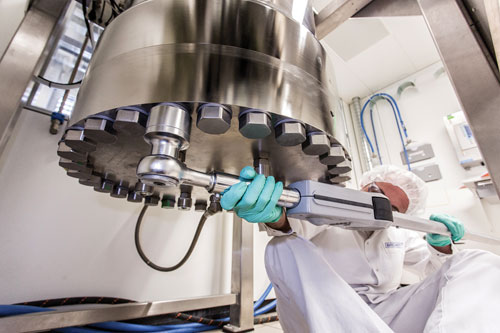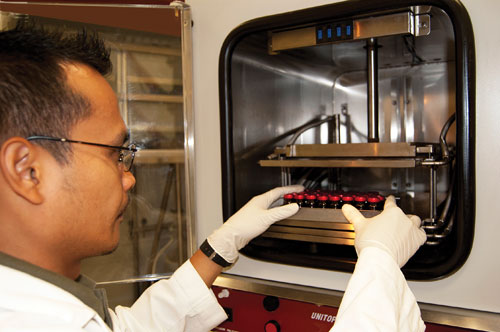July 1, 2015 (Vol. 35, No. 13)
Its Latest Forays Encompass Ever Larger, More Complex Molecules
Of the 65 or so peptide drugs that have gained FDA approval since 1970, nearly all have to be delivered via injection, infusion, or slow release (depot) therapy.
Alternative formulations—transdermal, inhalational, intranasal, and oral—still lag, with the delay usually attributed to peptides’ well-known bioavailability issues.
“Nature is nature,” says Jim Hampton, executive vice president for business development at AmbioPharm. “Peptides are as bioavailable as nature allows them to be.”
Peptides are too large and too charged to behave like small molecule drugs with predictable pharmacokinetics and pharmacodynamics. As a result, a peptide that costs $100 per gram to manufacture with bioavailability of 10% has an effective cost of $1,000 per gram. Cost has long been the most significant impediment in the development of peptide drugs and multiple formulation strategies.
Until the late 1990s, many peptide drugs were manufactured recombinantly. Synthetically manufactured peptides were difficult to scale because amino acids and solvents were prohibitively expensive, synthetic manufacturing processes were primitive, and production sites were outdated and located in high-cost countries.
Since the advent of process improvements, more favorable sourcing of raw materials and solvents, and advanced protection and coupling chemistries over the last 15 years, synthetic chemistry now predominates peptide drug manufacture at small to very large scales. Protected amino acid costs have plummeted 90%, to the point where the need for exotic half-life extension techniques such as PEGylation is becoming moot: The marketplace now supports 10% bioavailability for nasal, transdermal, and oral delivery.
“Lower costs have liberated peptides from being largely an injectable business opportunity,” Hampton tells GEN.
Recombinant manufacture has simultaneously become largely irrelevant except for certain peptides, such as insulin, that are inaccessible by synthetic routes. The entry barrier for developing a cell- or microorganism-based expression system is now beyond the reach of many smaller drug firms. Besides, whereas synthesis of significant quantities of GMP-worthy peptide for a clinical study can take approximately three months, a cell-line development project can take a year or longer, with no guarantee that production levels will support a product’s development phase.
“Companies are looking for speed to clinic and proof of concept for their drugs in humans because these attributes generate funding,” Hampton adds.
The greatest material contributor to cost of goods is no longer the supply of amino acids but solvents. From the process perspective, synthesis is highly scalable, but purification and lyophilization have emerged as cost concerns. The latter is of particular concern because it defines the physical form of orally delivered peptide drugs.
AmbioPharm’s business strategy exploits today’s science and economics. The company manufactures its peptide active pharmaceutical ingredients (APIs) in China, where the costs of labor, protected amino acid building blocks, and solvents are a fraction of those in Europe and the United States. The company recycles dimethylformamide, the principal organic solvent for peptide synthesis, and sells it to a paint manufacturer. APIs are further purified in the United States via large-column high-pressure chromatography.
Proof of Concept
Bachem, an API manufacturer, specializes in medium to large, complex peptides, all chemically synthesized. In partnership with GlyTech, a Japanese manufacturer of glycosylated drugs, the company recently completed a proof-of-concept synthesis of interferon beta-1a, a 166-amino acid glycoprotein that is also PEGylated.
“We wanted to demonstrate that even for a very large peptide that is normally expressed in recombinant organisms, chemical synthesis is a competitive process,” says Martina Diekmann, Ph.D., head of global marketing. The interferon molecule was produced through convergent methodology involving the linking of relatively small peptide subunits.
While interferons will continue to be manufactured recombinantly, Bachem’s achievement is nevertheless remarkable. “Many of our customers have to decide on whether to go synthetic or recombinant,” Dr. Diekmann continues. “We try to convince them that the synthetic route has significant advantages, even for larger, more complex, and modified peptides.”
The willingness to accommodate complexity will increase, according to Diekmann, as there is an increased interest in modifications of the peptide chain, the incorporation of unnatural amino acids, and the discovery and development of polycyclic and macrocyclic peptides.
The major advantage of chemical synthesis is the potential for having a complex product in hand within an economically attractive timeframe, compared with one year or longer for a recombinant production system. Purification and analysis are also more straightforward: Where synthesis generates a single product, recombinant molecules must be separated from genes and host cell proteins. Solid-phase peptide synthesis is also more practical in today’s “fail fast” environment, which does not allow for large investments in process development prior to proof-of-concept in the clinic.
“Synthesis also provides the opportunity to fine-tune pharmacological properties such as bioactivity, receptor selectivity, or half-life,” asserts Dr. Diekmann. Selective glycosylation opens the door to designer peptides with improved circulating half-life, greater efficacy, or lower immunogenicity—what Diekmann calls “second-generation drugs.” Approximately 25% of the newly approved peptide drugs since 2012 are glycosylated.
Not all peptides under development approach proteins in size. Trishul Shah, associate director of business development at contract peptide manufacturer PolyPeptide Laboratories, notes that cell-penetrating peptides (CPPs) typically contain fewer than 40 amino acids and often fewer than 20.
Also known as protein transduction domains and Trojan peptides, CPPs deliver to cells a variety of payloads, such as DNA, silencing RNA, cytotoxic drugs, plasmids, proteins, and nanomaterials. CPPs are all made synthetically.
CPP binding to and uptake into cells is not completely understood, although this function is tunable through standard chemical means. “They penetrate because they contain a lot of positively charged lysine and arginine residues,” Shah explains, “or alternating patterns of polar and nonpolar amino acids.”

Bachem indicates that it is systematically expanding and modernizing its purification equipment to ensure the efficient production of large amounts of bulk peptide pharmaceuticals. The preparative HPLC column shown here has a diameter of 24 inches (60 cm).
Neither Here nor There
In the past, peptide manufacturing was considered to be as much an art as a science. Protection, deprotection, and coupling chemistries were inefficient to the point that overall yield for a 7- or 8-mer might be under 10%. Modern synthesis methods, which make similar yields accessible in the production of 35-mer peptides, now compete with many small molecule syntheses.
For Stacie Schroeder, senior vice president of sales and marketing at CPC Scientific, the biggest issue for peptides as drugs is their intermediary position, from chemical and regulatory perspectives, compared with other molecules. “They are not biologics, or proteins, or small molecules,” Schroeder says. “Drug developers are unsure of the regulatory strategy they should adopt.”
Although peptide specialty firms such as CPC are perfectly comfortable producing peptides for research and clinical-grade materials, many drug developers feel less assured—perhaps because they lack experience, or because they still remember less-than-pleasant peptide experiences from years ago.
Peptide production tends to be more complex than for small molecules. “It’s a fairly long process, but peptide firms have improved peptide production significantly over the years,” Schroeder observes. “It’s a wonder more drug developers don’t look at peptides.”
Schroeder has noticed an uptick for peptide drugs moving from preclinical to Phase I and beyond, but she is unsure why this is occurring. It could be that drug developers are seeing the light, or it could just be a function of the improving economy.
Peptides’ reputation for high cost arose through a combination of poor bioavailability and the long, tedious manufacturing process, which traditionally translates to higher cost per unit. “Peptides do tend to cost more on a unit basis, but their higher efficacy compared with small molecule drugs means doses can be smaller,” Schroeder explains.
Peptide manufacturers have made great strides toward process economy, pushing traditional solid-phase peptide synthesis to larger scales and greater yields. Schroeder also mentions fragment condensation, or hybrid technology, as becoming more economical. Fragment condensation refers to what organic chemists call “convergent synthesis,” or making several smaller pieces separately and joining them together. The different parts of the peptide may be produced by different processes including solid-phase peptide synthesis, liquid-phase peptide synthesis, or recombinant techniques.
Moving the Goalposts
Continuing improvements in peptide manufacturing have given rise to complex products, some branched, some containing artificial amino acids. “The synthesis of simple linear peptides is almost passe,” says Mike Pennington, Ph.D., president and CEO of Peptides International. Sequences of 80 amino acids and longer, containing multiple disulfide linkages, are now routine. For example, synthetic parathyroid hormone consists of 84 amino acids. “Companies are working on making and purifying synthetic peptides with lengths similar to those of parathyroid hormone, and doing so at scale,” Dr. Pennington adds.
In addition to providing peptide, protein, and organic compound services and products for research markets Peptides International has a clinical-stage compound in development that it says in an analogue of Stichodactyla Toxin (Amide). This compound, which is also known as dalazatide, and which was once known as ShK-186, is a first-in-class peptide for treating autoimmune disorders. It inhibits immune-inducing T cells and has shown efficacy against psoriasis in recently completed Phase Ib studies, and it is moving into Phase IIa studies.
One would think that at some molecular-weight or amino-acid cutoff value, recombinant production would make more sense than chemical synthesis. That boundary keeps moving upward, however, as synthetic capabilities improve.
“In some cases, as you approach the size of proteins, it makes sense to use an expression system,” Dr. Pennington admits. “But amidated peptides, which constitute a fair proportion of therapeutic molecules, are not easily handled by recombinant systems. Also, some development-stage peptides employ nonnatural amino acids.” It is possible to code for these using artificial nucleotides, but this approach is unsuitable for large-scale production.
In addition, many new peptides have branch points or employ PEGylation, which is not genetically coded. Several vaccines in development, moreover, consist of multiepitope peptides—some with as many as 15 subcomponents.
Interestingly, peptides with multiple cysteine residues tend to form disulfide bonds in the native configuration, which is also the most stable thermodynamically. “Molecules with six cysteines can form fifteen possible disulfide isomers, but one is usually favored because bonds form in such a way that hydrophobic residues point inward,” Dr. Pennington explains. He calls this “God-assisted folding.” Disulfide bond formation can also be directed by the strategic addition of protecting groups, but this strategy is unreliable for cGMP manufacturing.
Excitement over peptide drugs has waxed and waned over the years, as have predictions of great successes right around the corner. Could this time be different?
Ambiopharm’s Jim Hampton believes the confluence of advanced chemistry and better appreciation for process economics will boost peptides as development-stage pharmaceuticals. He expresses confidence that developers are “on the cusp of a new era for peptide drug approvals.”

A scientist at Peptides International inserting a tray of vials into a lyophilizer.


